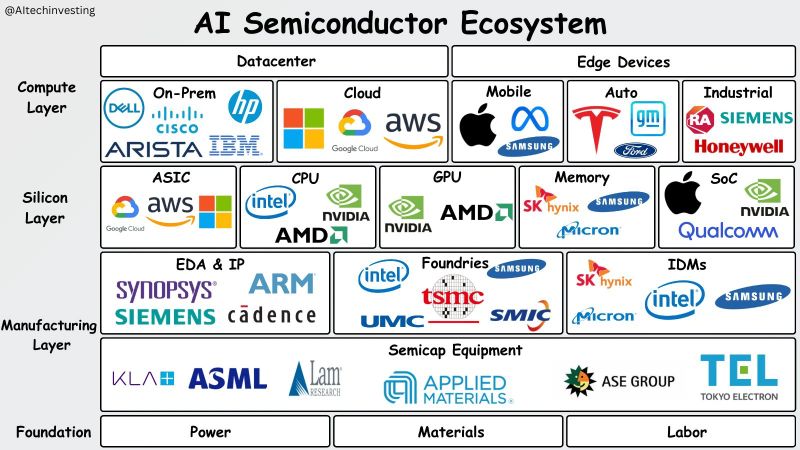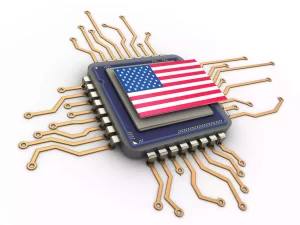Introduction
In the fast-paced world of artificial intelligence, the semiconductor ecosystem plays a pivotal role in shaping the landscape of computing. This intricate web can be categorized into four layers, each contributing to the development, manufacturing, and deployment of AI-driven technologies. Let’s delve into the details of each layer to unravel the complexities that make up the AI semiconductor ecosystem.
Follow us on Linkedin for everything around Semiconductors & AI
Why do these players matter?
The players in the AI market ecosystem are closely scrutinized for various compelling reasons that collectively contribute to their prominence and impact on the industry.
Firstly, these companies are distinguished by their commitment to innovation and technological advancements. By consistently investing in research and development, they remain at the forefront of introducing cutting-edge AI technologies and solutions. Monitoring their activities provides valuable insights into the latest breakthroughs and emerging trends within the field.
Additionally, the market influence and leadership held by these key players make them significant entities to observe. Their substantial market share and ability to shape industry trends indicate a strong competitive position. By keeping an eye on these leaders, industry observers can gain a deeper understanding of the direction in which the AI market is evolving and the standards that are being set.
Strategic partnerships and collaborations form another pivotal aspect of why these players are closely watched. Recognizing that strength lies in numbers, companies in the AI ecosystem frequently engage in partnerships, collaborations, and acquisitions. These activities signify efforts to enhance capabilities, expand market reach, and maintain a competitive edge. Observing these strategic moves provides valuable insights into the dynamic and evolving landscape of AI.
The product and service offerings of major players are influential benchmarks within the AI industry. These companies often set the standard for quality and functionality. Monitoring their product releases and service expansions allows stakeholders to gauge industry norms and anticipate customer expectations. Innovations introduced by these key players have a cascading effect, influencing the entire AI ecosystem.

Image Credits: AI Semiconductor Ecosystem
Major players and their Roles
| Layer | Key Components and Functions |
|---|---|
| Compute Layer | – AI Computing in Datacenters: Massive clusters of servers with GPUs and CPUs for parallel processing of AI workloads. |
| – Edge Devices: Local processing on devices like smartphones and IoT devices, reducing latency and enabling intelligent decision-making on the spot. | |
| Silicon Layer | – GPUs Dominating Data Center Workloads: Parallel architecture excelling in matrix calculations for deep learning. |
| – CPUs and ASICs: CPUs for general-purpose computing; ASICs for specialized AI tasks. | |
| – System-on-Chip (SoC): Integration of multiple components onto a single chip, prevalent in mobile devices. | |
| – Memory: High-bandwidth memory (HBM) and advanced memory technologies for rapid data access and efficient AI algorithm execution. | |
| Manufacturing Layer | – EDA Tools: Electronic Design Automation software for chip design and optimization. |
| – Foundries: Factories mass-producing chips based on EDA designs, utilizing advanced fabrication technologies. | |
| – Integrated Device Manufacturers (IDMs): Companies designing and fabricating their own chips for greater control over the production pipeline. | |
| Foundational Layer | – Resource Requirements: High computational power demands for AI training models and their impact on global electricity consumption. |
| – Environmental Impact: Foundries’ consumption of resources, including millions of gallons of water daily, emphasizing the need for sustainable practices. | |
| – Skilled Labor: Engineers, researchers, and technicians driving innovation in semiconductor design, manufacturing, and deployment. |
1. Compute Layer:
AI Computing in Datacenters:
Datacenters serve as the beating heart of AI computations. Massive clusters of high-performance servers equipped with GPUs, CPUs, and other specialized chips power the most demanding AI workloads. The synergy of these components allows for parallel processing, enabling datacenters to handle complex tasks such as deep learning, neural network training, and large-scale data analysis.
Edge Devices:
The AI revolution is not confined to datacenters alone. Edge devices, ranging from smartphones and smart cameras to IoT devices, are integral to the compute layer. These devices process information locally, reducing latency and enhancing privacy by avoiding constant data transfers to the cloud. AI algorithms optimized for edge computing empower devices to make intelligent decisions on the spot.
Read More: Singapore Data Center Boom is Catalyst for Nvidia’s Staggering 15% Revenue
2. Silicon Layer:
GPUs Dominating Data Center Workloads:
Graphics Processing Units (GPUs) have emerged as the workhorses of AI in datacenters. Their parallel architecture excels at handling the matrix calculations essential for deep learning. GPUs accelerate training of complex models and power inference tasks, making them indispensable in the AI semiconductor ecosystem.
CPUs and ASICs:
Central Processing Units (CPUs) remain vital for general-purpose computing, but certain AI workloads demand specialized processing units. Application-Specific Integrated Circuits (ASICs) are custom-designed chips optimized for specific tasks, providing unparalleled performance for dedicated AI applications. The system-on-chip (SoC) architecture, prevalent in mobile devices, integrates multiple components onto a single chip for enhanced efficiency.
Memory:
In the silicon layer, memory is a linchpin. High-bandwidth memory (HBM) and other advanced memory technologies ensure rapid access to data, facilitating the seamless execution of AI algorithms. Efficient memory management is crucial for sustaining the computational demands of AI workloads.
Read More : What are Top 3 Market Leaders in Processor Space: Moats and Competion
3. Manufacturing Layer:
EDA Tools:
Electronic Design Automation (EDA) tools are the architects’ toolkit for designing semiconductor chips. These software solutions aid in the creation and verification of complex chip designs, optimizing performance, power consumption, and area utilization.
Foundries:
Foundries are the factories where semiconductor chips come to life. They mass-produce chips based on the designs created using EDA tools. Leading foundries employ cutting-edge fabrication technologies, including advanced lithography, to produce chips with increasingly smaller transistor sizes, enhancing computational power and energy efficiency.
Integrated Device Manufacturers (IDMs):
Some companies take a different approach by owning both the design and manufacturing processes. Integrated Device Manufacturers (IDMs) design and fabricate their own chips, giving them greater control over the entire production pipeline.
Read More: What are the 5 Major Players in Global Foundry Market Share
4. Foundational Layer:
Resource Requirements:
The AI semiconductor ecosystem places significant demands on resources. The computational power required for AI training models is energy-intensive, contributing to the global electricity consumption. This layer highlights the environmental impact of AI technologies and emphasizes the need for sustainable practices in the semiconductor industry.
Environmental Impact:
Foundries, crucial to chip manufacturing, are large consumers of resources, including millions of gallons of water daily. Addressing the environmental impact of semiconductor production is becoming increasingly important, prompting the industry to explore more sustainable practices and technologies.
Skilled Labor:
The intricate process of designing, manufacturing, and deploying semiconductors requires a skilled workforce. Engineers, researchers, and technicians play pivotal roles in pushing the boundaries of AI technology. Investing in education and training programs is essential to maintain a skilled workforce capable of driving innovation in the semiconductor industry.
In conclusion, the AI semiconductor ecosystem is a multifaceted network of technologies and processes that converge to bring artificial intelligence to life. From the immense computational power in datacenters to the intricacies of chip design and manufacturing, each layer plays a crucial role in advancing the capabilities of AI technologies. As we navigate this dynamic landscape, it’s imperative to balance innovation with environmental consciousness and invest in the skilled human capital that propels the semiconductor industry forward.
Read More: Why these 14 Companies Are Poised to Explode AI Chip Market to $300B by 2030
Conclusion:
In the ever-expanding universe of artificial intelligence, our exploration has revealed a landscape rich with diverse influences and innovators. From the commanding presence of tech titans to the nimble strides of startups, the AI ecosystem thrives on collaborative ingenuity. As we conclude this journey, it’s evident that the synergy among major players continues to propel AI’s evolution, promising a future where intelligence meets limitless possibilities.







